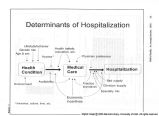| OCR Text |
Show Another question regarding reporting of rates by diagnosis (or by procedure) is whether to use the first listed diagnosis or all listed diagnoses (in Utah, up to five diagnoses are currently listed in the statewide public data set; individual hospitals may list more). Again, different investigators have used different approaches. The concept of an underlying cause of death, used for death certificate data, might be a useful model to adapt for use with hospitalization data. In that model, a standardized algorithm is used to select one diagnosis that initiated the chain of events leading to death. At present, reporting of hospital discharge rates by diagnosis has not been adequately standardized to facilitate ready comparison among different reports from different sources. Limitations The major limitation in using hospital discharge data for health status assessment is that rates can be high or low because of either utilization or need. Thus, in the absence of other information, interpreting the significance of hospitalization rates that are high or low can be difficult. For example, hospitalizations for prostate surgery might decrease because of a decline in prostate cancer incidence, a decline in screening for prostate cancer, or outpatient surgery becoming an accepted method of care. Increased availability and use of hospital discharge data might lead to identification of conditions that primarily are affected by only one factor and can be reliably used to assess either occurrence or utilization. A second issue is that coding practice varies. Hospital discharge data are derived from what has been primarily an administrative data base. Problems with coding changes prompted by reimbursement incentives have been identified (Steinwald & Dummit, 1989). Additional validation studies are needed. It is likely that increased utilization of state-level data will both identify more problems and gradually lead to improved data accuracy and consistency. Migration of patients across geographic boundaries is also a problem for population-based analyses. This is a substantial problem in areas of the United States with high population density where a large proportion of residents of one state may obtain care in another. It is less of a problem in Utah, but can still be important for some of the border areas. It should become less important as more states develop data sets and agreements that facilitate sharing of data, as is done for vital statistics data. Finally, many statewide hospital discharge data sets do not include a unique identifier. Therefore, rates of discharges can be calculated for a condition but not for persons who have a condition. Each repeat admission by one person for the same condition is counted as a new health event. This is a problem for estimating disease occurrence. For example, by using a set of proxy unique identifiers, we estimated that the number of persons hospitalized in Utah for ischemic heart disease each year is about 87 percent of the number of hospitalizations each year for that condition. This is less of a problem for other uses, such as ACS conditions or variation in utilization. Conclusion Hospital discharge data can be an important addition to the data currently used for health status assessment. It could be particularly useful as a measure of occurrence for conditions that do not commonly cause death. Analyses of ACS conditions also show promise for guiding interventions to improve health care access. It is important to recognize that hospitalization rates are affected by factors other than need, however. In addition, both standardization of reporting methods and increased attention to data accuracy are needed. Notes 1. If the increasing importance of managed care makes it possible to define populations that are served by particular health plans or health care systems, by means other than geographic boundaries, a different type of population-based analysis than described here would be possible. 2. Interested readers should see the following: Bunker, 1970; Wennberg, 1973; Paul-Shaheen, Clark, Williams, 1987; Chassin et al., 1986; Chassin et al., 1987; Connell et al., 1984; Wennberg et al., 1989; Leaps, Park, & Solomon et al., 1989; Leaps, Park, & Solomon et al., 1990; Holahan et al., 1990; Roos & Roos, 1982; Perrin, Homer, Berwick et al., 1989; Fisher, Wennberg, Stukel & Sharp, 1994; Wennberg, Freeman, Shelton & Bubolz, 1989; Connell, Day & LoGerfo, 1981; Roos, Wennberg & McPherson, 1988; Wennberg & Gittelsohn, 1982; McMahon, Wolfe, Griffith & Cuthbertson, 1993; Chassin, 1993. 3. Interested readers should see the following: Weissman, Gatsonis & Epstein, 1992; Billings, Zeitel, Lukomnik et al., 1993; Braveman et al., 1994; Carty, Celebi, Shields & Edwards, 1994; Krasner, 1994; Bindman, Grumbach, Osmond et al., 1995. 4. The zip code is usually available with hospital discharge data. If addresses were available, census tract or block group could be used in a similar manner as the zip code. 30 Hospital Discharge Data |


























































































































































